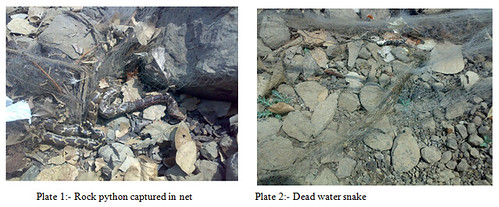Authors: P. B. Ingle* ,D.R. Sapkal** and V.R. Sapkal
*Shiv Chauk Deshpande Plots at Post Tq Malegaon, Dist. Washim (Maharashtra) 444503 (puruingle_5@rediffmail.com)
**Dr.D.R. Sapkal, Assistant Professor, Lovely Professional University, Jalandhar, State : Punjab (deepaksapkal7878@rediffmail.com)
(Watsagulma Biodiversity Conservation Society, Malegaon dist. Washim 444503, Maharashtra).
Fishing nets are used to capture the fishes in lakes and rivers. In many cases the nets are also used to save the fishing seeds from being flown away during rainy seasons. In dams where fishing permission is granted by government authority such fishing nets are ample. Net entanglement occurs when fish capturing nets are at, or close to the surface of water during capture of fishes. Birds, snakes attempting to seize fish from the net become entangled.
The Indian rock python (Python molurus molurus) belongs to reptiles, order-Squamata, suborder- Serpentes, the family Boidae, which contains the world’s largest snake species including pythons, boas and anacondas. It is distributed in forested areas of Pakistan, India, Sri Lanka, Southern Nepal, Bangladesh, Myanmar, Southern China, Thailand, Laos, Vietnam, Cambodia, Peninsula, Malaysia and Indonesia (McDiarmid et al., 1999, Molur, S. and S. Sanjay, 1998). Pythons inhabit a wide range of habitats including wetlands, open forest, scrublands, harsh desert, rainforests, woodlands, grassy marshes, river valleys, rocky slopes, and savanna. They live in hollows of trees, mangrove thickets, mammal burrows and dense water reeds (Whitaker, 1987); in caves and unattended remnants of old buildings with clumps of vegetation around, and is reluctant to move away from its established territory. P. molurus molurus is listed as Lower Risk/Near Threatened by International Union for the Conservation of Nature and Natural Resources (IUCN, 1994, 1996) (Molur, S. and S. Sanjay, 1998). It is also included in scheduled I of Wild Life (Protection) Act 1972. The Indian Rock Python is thick-bodied and smooth scaled and had head broader than neck. Eyes have vertical pupil and upper surface of head has large scales of different shapes. The overall color varies from body full of irregular shaped patches, black border. Common food habit of python is different types of Nematode, mammals and birds. It is also noted that larger specimens usually eat animals about the size of a house cat. It is often seen that whenever python eat mammal of larger size like of barking deer, it tend to harm itself. In the postmortem (PM) examination of one such case revealed bloody discharge through mouth and a couple of skin lacerations were observed on the right dorso-lateral part of the abdominal region. Three fractured ribs were also found on right thorax of python. (Bhajan et:al 20 13).
In the month of May, our team of Watsagulma Biodiversity Conservation society members went for the field visit to Patur eco-tourism center, District: Akola, State:Maharashtra, Country: India. During field visit at the Patur Lake we found the fishing net was lying down near the lake. On the closer observation of this net we could find skeletons of many dead snakes and birds (plate 2). In the same net live Indian rock python was also found. The members of society among which some are snake friends correctly identified the snake species (plate 1). They cut the net and rescued the python, immediately. Due to capture in net the python was injured. It was bleeding in neck area which might be due to the struggle made by python to get rescued from net. We immediately reported the incident to forest officer. When the staff of forest officer arrived they burnt that net and took the python with them for treatment.

Present rainy season very few fishing net was observed and authority personally pay attention to keep minimum fishing net and daily observing fishing net carefully. This indicates that authority has learned lesson from the incident happened in last year. By ignoring such a issue we are losing our valuable wild life (reptiles, mammals and birds) diversity. Same type of awareness should be generated in other water bodies where fishing permission is granted.
Acknowledgements:
The writers as thankful to Mr. Shivaji Bali, Mr. Jitendra Khandagale, Mr. Rajesh Sobhage, Mr. Milind Sawdekar who were present on the day of finding rock python in net, and all the members of Watsagulma Biodiversity Society.
References
1. Bhajan Chandra Das, Dibyendu Biswas, Mohammed Forhad Hossain, Shubhagata Das,
Amam Zonaed Siddiki and Abdul Mannan. (2013) A postmortem experience of Indian rock python (Python molurus molurus) that swallowed a whole barking deer. doi:10.5455/vetworld.2013.163-165
2. Molur, S. and S. Sanjay, 1998. Reptiles of India.Biodiversity Conservation Prioritisation Project Since the forests (BCPP) India, Endangered Species Project are Conservation Assessment and Management Plan (C.A.M.P.) workshops. Zoo Outreach Organisation and CBSG, India, Coimbatore, India.
3. Mc DIARMID, R. W., CAMPBELL, J.A. AND TOURE, T., 1999. Snake species of the world: A taxonomic and geographic reference, Vol. 1. Herpetologists' League, pp. 511.
4. WHITAKER, R., 1987. Common Indian snakes â€" A field guide. The Macmillan Company of India Limited, pp. 6-9. SBN 33390-198-3.
About Author / Additional Info: